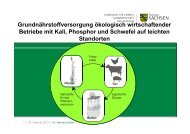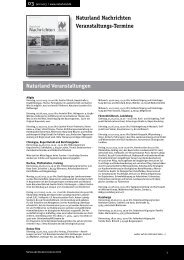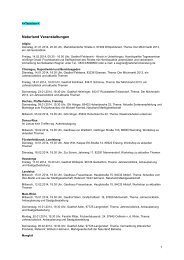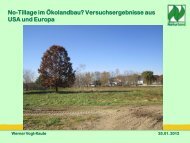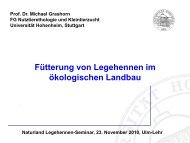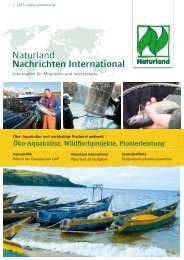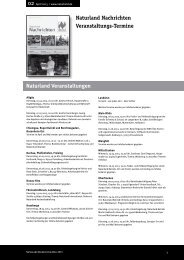Organic Farming in the Tropics and Subtropics: Sesame - Naturland
Organic Farming in the Tropics and Subtropics: Sesame - Naturland
Organic Farming in the Tropics and Subtropics: Sesame - Naturland
You also want an ePaper? Increase the reach of your titles
YUMPU automatically turns print PDFs into web optimized ePapers that Google loves.
II Special section: <strong>Organic</strong> Cultivation of <strong>Sesame</strong><br />
Larger distances stimulate branch<strong>in</strong>g, even with s<strong>in</strong>gle stem varieties. This makes<br />
harvest<strong>in</strong>g more difficult, without <strong>in</strong>creas<strong>in</strong>g <strong>the</strong> yield. When <strong>the</strong> correct amount of<br />
seeds are sown, no s<strong>in</strong>gl<strong>in</strong>g is necessary.<br />
2.4. Diversification strategies<br />
2.4.1. Crop rotation<br />
When cultivat<strong>in</strong>g sesame, <strong>the</strong> follow<strong>in</strong>g aspects should also be considered when<br />
plann<strong>in</strong>g <strong>the</strong> crop rotation:<br />
• Do not cultivate directly follow<strong>in</strong>g a fallow period (uneven soil, weed<br />
proliferation),<br />
• As weed-free seed beds as possible (important when select<strong>in</strong>g <strong>the</strong> previous<br />
crop),<br />
• Previous crops with few dem<strong>and</strong>s on <strong>the</strong> soil,<br />
• <strong>Sesame</strong> is also a good prelim<strong>in</strong>ary crop (it loosens <strong>the</strong> soil with its tap roots,<br />
<strong>and</strong> provides a dense network of roots <strong>in</strong> <strong>the</strong> upper layer),<br />
• Well-suited as a second crop (short vegetation period, use of water stored <strong>in</strong><br />
<strong>the</strong> soil <strong>in</strong> a similar way to sorgo, as well as be<strong>in</strong>g resistant to drought),<br />
• Resistant aga<strong>in</strong>st root nematodes,<br />
• Keeps <strong>the</strong> wire worm (larvae of <strong>the</strong> beetles belong<strong>in</strong>g to <strong>the</strong> family of elateridae)<br />
under control <strong>in</strong> <strong>the</strong> crop rotation.<br />
Typical crop rotation partners <strong>in</strong>clude cotton, gra<strong>in</strong> legumes (peanuts, varieties of<br />
beans, soya etc.), maize, dry rice <strong>and</strong> sorgo.<br />
Examples for crop rotation <strong>in</strong> various parts of <strong>the</strong> world:<br />
Turkey Chick peas - wheat (or barley) – sesame<br />
Ug<strong>and</strong>a Cotton - sesame - maize+beans – fallow<br />
South Brazil W<strong>in</strong>ter:Second crop: green fertiliser with white<br />
lup<strong>in</strong>es/vetch/oats or field beans/sun flowers<br />
1.Summer: Maize<br />
2.Summer: Adzuki beans or soya<br />
3.Summer: <strong>Sesame</strong><br />
Naturl<strong>and</strong> e.V. – 1 st edition 2000 Page 6





